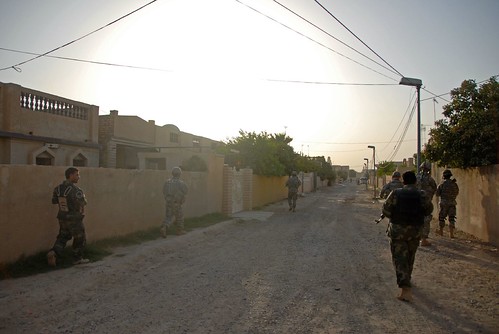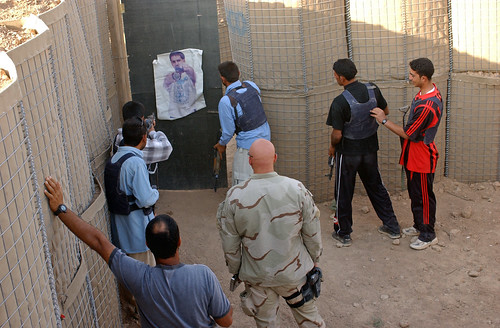Developing Iraqi Security Forces: A Long, Difficult, and Dangerous Process - But Not a Hopeless One
Note: Click here for the rest of Jeff's reports from the front lines in Iraq
September 27, 2007
Samarra, Iraq
The development of Iraqi Security Forces (ISF) – consisting of Iraqi Police (‘IPs,’ who are under regional control), National Police (‘NPs,’ who belong to the federal government’s Ministry of Interior), and Iraqi Army – has been both a priority and a point of frustration for the coalition forces who are trying to train them as quickly and effectively as possible to fill the role currently being served in Iraq by the U.S. military.
For the most part, when working with – or supported by – Americans, both their planning and their execution are carried out at a relatively high level. When working on their own, they are both less proficient at their duties and more prone to attack (as they present a softer target than coalition forces do); however, if backed by the coalition (both verbally and through the provision of extra firepower, even if it is only to be used in the case of emergency), the forces perform relatively well, and, though they cannot yet hold a candle to their American counterparts in either proficiency or professionalism, they are showing improvement as they get more time and practice under their belts.
 |
During my time here in Iraq, I have patrolled neighborhoods with coalition and Iraqi forces, attended elite Iraqi Police training courses conducted by US Special Forces, and gone on operations entirely planned and led by ISF units. These forces have succeeded not only in securing roads and portions of cities, but also in executing large-scale offensive operations, which have occasionally resulted in the apprehension of very high-level targets and groups, including a particularly brutal al Qaeda cell in Samarra, which the ISF broke up earlier this week.
 |
In Samarra, the Sunni city which was the site of the 2006 Golden Mosque bombing (and which still houses the 1,255-year old Great Samarran Mosque, formerly the largest such structure in the world, and its striking 52-meter tall spiral minaret), approximately 1,500 police are working alongside, and learning from, the paratroopers of Charlie Company 2-505 (from the 82nd Airborne), who have been on the ground in Samarra since August 2006.
ISF in the city are largely based within what is called the ‘Green Zone,’ which is a secure area between Patrol Base Olson (Charlie Co.’s headquarters in Samarra) and three ISF Battle Positions, which provide outer security for the Patrol Base. Olson sits in the northwest corner of Samarra, and the three Battle Positions (known, from northeast to southwest, as BPs 3, 4, and 5) serve both as ISF bases of operations in the city and as a security screen for the coalition post. Patrol Base Uvanni, an outpost in the heart of the city that housed one battalion of the 101st Airborne Division’s 3rd Brigade until it was turned over to ISF by coalition forces in March 2006, is currently home to one remaining battalion (approximately 600 personnel) from the Askyrian (Samarran) Brigade.
While Samarra’s Iraqi and National Police have been trained by conventional American soldiers as well as by Special Forces, and have been used on countless patrols and missions in the city, their growth and development has been hampered by a long string of massive and deadly attacks by al Qaeda (known to themselves the ‘Islamic State of Iraq,’ or ‘ISI’) in the area, the most spectacular of which involved a coordinated attack on BP 4, the Iraqi Police battle position directly in front of PB Olson, which culminated in the suicide VBIED attack that killed the extremely effective local IP commander, Colonel Jaleel, along with an incalculable number of his men.
On May 6 of this year, a group of al Qaeda (made up of both ISI members and several foreign fighters) launched an all-out assault on BP4. In the midst of the fight, a minivan filled with at least six beer keg-sized barrels of homemade explosive (along with three 155mm artillery shells) was driven right up to the battle position and detonated, killing dozens of ISF, destroying the compound there, and fracturing the main that served as the city’s primary source of water. It was in this incident that Colonel Jaleel was killed, as he stood with his personal security detachment, long after the rest of his men had fled, standing tall and facing down the al Qaeda fighters and the approaching vehicle until the very end.
Following the massive VBIED, Charlie Co.’s paratroopers took 48 hours off from their operations in the city to do the job of engineers, fixing the broken water main as quickly as possible and restoring the flow of water to the city, while also providing security and delivering water and gas to the residents.
Like those positioned at BP4 on that fateful day in May, many of the ISF units assigned to Samarra have seen their tenures here – and, all to often, their lives – end in ignominious defeat, whether as a result of VBIED attacks and assaults on their positions, or of their decision to flee the city before such attacks could take them.
This problem is being addressed in one way with the construction of a massive new National Police barracks and training center just north of the western end of the city, which will also serve as an operating base for 1,500 new ISF personnel when they begin arriving in Samarra later this month. Adding to that increase in numbers will be 800 more NPs, who in November will move to Patrol Base Uvanni when that compound is refurbished and expanded. Both jobs are being carried out by Iraqi workers, who are overseen by an extremely competent Baghdadi contractor.
This new wave of ISF is the latest of those that have repeatedly been sent to the city in the wake of their predecessors’ departing. However, each time that police on whom so much time and effort has been spent are killed or driven out of the city and replaced with largely raw recruits, the cycle of slowly nursing along a fledgling force is restarted. As one Special Forces officer put it to me, “the best metaphor is probably trying to build an airplane while in flight. We have to train these guys by day while fighting alongside them by night” – and losing the men in whom so much has been invested serves to make that job all the more difficult.
Since the death of Colonel Jaleel, both NPs and IPs in Samarra have fallen fall under the command of the large, gregarious, charismatic, and lethally effective General Rasheed, the National Police commander for the area. Under the watch of Rasheed and his officers (and with the guidance of Major Travis Southwick, the coalition Civilian Police Assistance and Training Team advisor to the General), the current crop of ISF in Samarra – aided by the four National Police Transition Teams, one Military Transition Team, and one Police Transition Team in the area – is once again progressing, growing more effective and learning how to carry out their duties. Within the last week alone, the Police have not only accompanied coalition forces on an average of two patrols per day, but have also carried out three large-scale clearing missions on their own, with coalition forces only there to provide a gentle, reassuring hand if and when it was needed.
“These guys are getting too efficient,” said Charlie Co. commander Captain Buddy Ferris, with only the slightest hint of irony, as we walked out of Uvanni one night earlier this week after observing the latest NP operation. “If they keep this up, it’ll be about time for another VBIED to hit them.”
The ISF – and the coalition – in Samarra can only hope that they are improving quickly enough to be ready enough for such a situation, should it once again be attempted, to be able to stop it before it happens.
Jeff Emanuel, a special operations veteran of Operation Iraqi Freedom, is a columnist and a director of conservative weblog RedState.com. He is currently embedded with the U.S. military on the front lines in Iraq, and his reports can be seen at www.JeffEmanuel.com.
***************
This mission is 100% funded by reader donations. If you would like to help continue to make this reporting possible, please consider clicking the PayPal link on the right sidebar and making a contribution. You can email Jeff at InsideTheSurge@Gmail.com.


